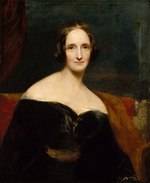Portal:Speculative fiction/Horror

Selected horror profileMary Shelley (née Mary Wollstonecraft Godwin; 30 August 1797 – 1 February 1851) was a British novelist, short story writer, dramatist, essayist, biographer, and travel writer, best known for her Gothic novel Frankenstein: or, The Modern Prometheus (1818). She also edited and promoted the works of her husband, the Romantic poet and philosopher Percy Bysshe Shelley. Her father was the political philosopher William Godwin, and her mother was the philosopher and feminist Mary Wollstonecraft.
Mary Godwin's mother died when she was eleven days old; afterwards, she and her older half-sister, Fanny Imlay, were raised by her father. When Mary was four, Godwin married his neighbour, Mary Jane Clairmont. Godwin provided his daughter with a rich, if informal, education, encouraging her to adhere to his liberal political theories. In 1814, Mary Godwin began a romantic relationship with one of her father’s political followers, the married Percy Bysshe Shelley. Together with Mary's stepsister, Claire Clairmont, they left for France and travelled through Europe; upon their return to England, Mary was pregnant with Percy's child. Over the next two years, she and Percy faced ostracism, constant debt, and the death of their prematurely born daughter. They married in late 1816 after the suicide of Percy Shelley's first wife, Harriet. Selected horror workHalloween III: Season of the Witch is a 1982 American horror film and the third installment in the Halloween series. Directed by Tommy Lee Wallace and starring Tom Atkins, Stacey Nelkin and Dan O'Herlihy, the film is based on an original screenplay by Nigel Kneale and focuses on an evil scheme by the owner of a mask company to kill the children of America on Halloween night through a series of popular Halloween masks: a witch, a jack-o'-lantern, and a skull. Season of the Witch is unrelated to the previous films featuring the character Michael Myers, and was intended to begin Halloween as an anthology series, releasing a new Halloween storyline every year. The only connection this movie has with the others in the series is a scene where the trailer for Carpenter's original 1978 Halloween is airing on a TV. Besides wholly abandoning the Michael Myers plotline, Halloween III departs from the slasher film genre which the original Halloween spawned. The focus on a psychopathic killer is replaced by a "mad scientist and witchcraft" theme. Produced on a budget of $2.5 million, Halloween III grossed $14.4 million at the box office in the United States. In addition to relatively weak box office returns, most critics gave the film negative reviews. Where Halloween had broken new ground and was imitated by many genre films following in its wake, this third installment seemed hackneyed to many. One critic twenty years later suggests that if Halloween III was not part of the Halloween series, then it would simply be "a fairly nondescript eighties horror flick, no worse and no better than many others." Horror topics
|


